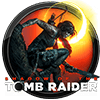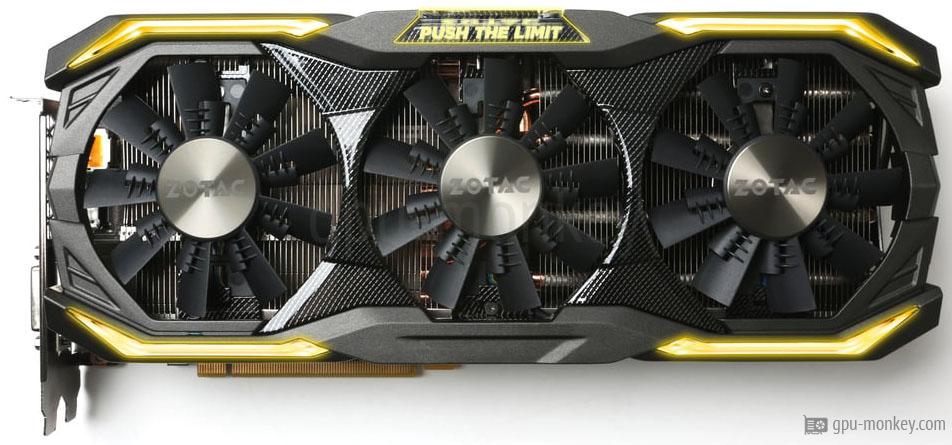
ZOTAC GeForce GTX 1080 AMP Extreme
Benchmark and Specs
Last updated:
Benchmark and Specs
All technical data and various benchmarks of the ZOTAC GeForce GTX 1080 AMP Extreme are listed on this page. The graphics card is based on the GP104-400-A1 / GP104-410-A1 (Pascal) graphics chip, which is manufactured with a structure width of 16 nm. The ZOTAC GeForce GTX 1080 AMP Extreme can operate up to 4 screens with a maximum resolution of up to 7680x4320 become.
GPUThe ZOTAC GeForce GTX 1080 AMP Extreme has 20 execution units with 2560 shaders. This gives the graphics card a theoretical FP32 computing power of 9.78 TFLOPS. |
|
| Based on: | NVIDIA GeForce GTX 1080 |
| GPU Chip: | GP104-400-A1 / GP104-410-A1 (Pascal) |
| Streaming Multiprocessors: | 20 |
| Shader: | 2560 |
| Render Output Units: | 64 |
| Texture Units: | 160 |
| Raytracing Cores: | 0 |
MemoryThe ZOTAC GeForce GTX 1080 AMP Extreme is equipped with 8 GB graphics memory of the type GDDR5X. The memory clock of the graphics card is 1.350 GHz and the speed is 10.8 Gbps. |
|
| Memory Size: | 8 GB |
| Memory Type: | GDDR5X |
| Memory Clock: | 1.350 GHz |
| Memory Speed: | 10.8 Gbps |
| Memory bandwidth: | 345 GB/s |
| Memory Interface: | 256 bit |
Clock SpeedsThe base frequency of this graphics card is 1.771 GHz and the manufacturer specifies the maximum turbo clock as 1.911 GHz. If supported (see below), the performance can be further increased by overclocking. |
|
| Base Clock: | 1.771 GHz + 10 % + 10 % |
| Boost Clock: | 1.911 GHz + 10 % + 10 % |
| Avg (Game) Clock: | |
| Overclocking: | Yes |
Thermal DesignThe ZOTAC GeForce GTX 1080 AMP Extreme is powered by 2 x 8-Pin connectors. The TDP (Thermal Design Power) of the graphics card is 270 W. |
|
| TDP: | 270 W + 50 % + 50 % |
| TDP (up): | -- |
| Tjunction max: | 94 °C |
| PCIe-Power: | 2 x 8-Pin |
Cooler & FansGraphics processor and graphics memory of the ZOTAC GeForce GTX 1080 AMP Extreme are cooled by a Air cooling. |
|
| Fan-Type: | Axial |
| Fan 1: | 3 x 100 mm |
| Fan 2: | -- |
| Cooler-Type: | Air cooling |
| Noise (Idle): | -- |
| Noise (Load): | -- |
ConnectivityUp to 4 monitors can be operated with the ZOTAC GeForce GTX 1080 AMP Extreme. |
|
| Max. Displays: | 4 |
| HDCP-Version: | 2.2 |
| HDMI Ports: | 1x HDMI v2.0b |
| DP Ports: | 3x DP v1.4 |
| DVI Ports: | 1 |
| VGA Ports: | -- |
| USB-C Ports: | -- |
FeaturesetWith the ZOTAC GeForce GTX 1080 AMP Extreme it is possible to operate a screen with a resolution of up to 7680x4320 pixels. Furthermore, the DirectX standard version 12_1 is supported. |
|
| Max. resolution: | 7680x4320 |
| DirectX: | 12_1 |
| Raytracing: | No |
| DLSS / FSR: | Yes |
| LED: | ZOTAC SPECTRA |
Supported Video CodecsThis area lists the video codecs that the ZOTAC GeForce GTX 1080 AMP Extreme can decode or encode in hardware in order to minimize the processor load, which leads to lower power consumption. |
|
| h264: | Decode / Encode |
| h265 / HEVC: | Decode / Encode |
| VP8: | Decode |
| VP9: | Decode |
| AV1: | No |
DimensionsThe ZOTAC GeForce GTX 1080 AMP Extreme needs the space of 3 PCIe-Slots in a case. It is 325 mm long, 148 mm high and -- wide. |
|
| Length: | 325 mm |
| Height: | 148 mm |
| Width: | -- |
| Width (Slots): | 3 PCIe-Slots |
| Weight: | -- |
Additional dataThe ZOTAC GeForce GTX 1080 AMP Extreme was released in Q2/2016 at a price of 599 $ (Reference). The graphics card manufactured in 16 nm is connected to the system via PCIe 3.0 x 16 lanes. |
|
| GPU Interface: | PCIe 3.0 x 16 |
| Release date: | Q2/2016 |
| Launch Price: | 599 $ (Reference) |
| Structure size: | 16 nm |
| Part-no: | ZT-P10800B-10P |
| Documents: | data sheet |
Rate this graphics card
Benchmark results
3DMark Benchmark (DirectX, Raytracing)
3DMark is a benchmark program that determines the performance of certain components of a computer and then reports the performance as a numerical value.
Time Spy Extreme Graphics score

|
ZOTAC GeForce GTX 1080 AMP Extreme
8 GB GDDR5X |
||

|
NVIDIA GeForce GTX 1080
Average of gpu group |
||
Port Royal (Raytracing)

|
ZOTAC GeForce GTX 1080 AMP Extreme
8 GB GDDR5X |
||

|
NVIDIA GeForce GTX 1080
Average of gpu group |
||
Battlefield 5
Battlefield 5 is a visually stunning game that is ideal as a graphics card benchmark. We test the game with maximum details on Windows 10.
3840x2160 (2160p)

|
ZOTAC GeForce GTX 1080 AMP Extreme
8 GB GDDR5X |
||

|
NVIDIA GeForce GTX 1080
Average of gpu group |
||
2560x1440 (1440p)

|
ZOTAC GeForce GTX 1080 AMP Extreme
8 GB GDDR5X |
||

|
NVIDIA GeForce GTX 1080
Average of gpu group |
||
1920x1080 (1080p)

|
ZOTAC GeForce GTX 1080 AMP Extreme
8 GB GDDR5X |
||

|
NVIDIA GeForce GTX 1080
Average of gpu group |
||
Geekbench 6 (OpenCL, Vulkan, Metal)
Geekbench 6 is a cross-platform benchmark for main processors, which also carries out 3 different graphics benchmarks and outputs them in the form of a numerical value.
Geekbench 6 - OpenCL

|
ZOTAC GeForce GTX 1080 AMP Extreme
8 GB GDDR5X |
||

|
NVIDIA GeForce GTX 1080
Average of gpu group |
||
Geekbench 6 - Vulkan

|
ZOTAC GeForce GTX 1080 AMP Extreme
8 GB GDDR5X |
||

|
NVIDIA GeForce GTX 1080
Average of gpu group |
||
FP32 Performance (Single-precision TFLOPS)
The theoretical computing power of the graphics card with single precision (32 bit) in TFLOPS indicates how many trillion FP32 floating point operations the graphics card (GPU) can perform per second.
FP32 (TFLOPS)

|
ZOTAC GeForce GTX 1080 AMP Extreme
8 GB GDDR5X |
||
More benchmarks
In order to determine the performance of a graphics card, so-called "benchmarks" are carried out. The benchmark software carries out special calculations to determine the performance of a graphics card. We use so-called theoretical or synthetic benchmarks (e.g. 3D Mark) as well as real game benchmarks. To ensure real comparability of the results, we pay attention to the correct execution of the benchmarks as well as the condition of the graphics card and the system.We use the following benchmarks to measure the performance of a graphics card:

3DMark Benchmark
5,159 entries
5,159 entries

GTA 5 Benchmark
4,624 entries
4,624 entries

Shadow of the Tomb Raider
5,148 entries
5,148 entries

Battlefield 5
4,510 entries
4,510 entries

Geekbench 6
5,151 entries
5,151 entries

Crypto-Mining Ethereum Hashrate
3,506 entries
3,506 entries

Crypto-Mining Ergo Hashrate
3,737 entries
3,737 entries

Crypto-Mining Ravencoin Hashrate
3,664 entries
3,664 entries

Crypto-Mining Vertcoin Hashrate
2,459 entries
2,459 entries

FP32 Performance
5,522 entries
5,522 entries
Popular comparisons









